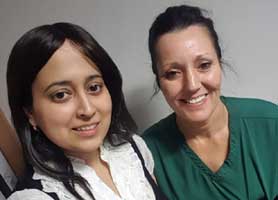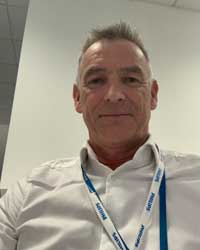
Well, good morning everyone. It’s really strange to see you all! I don’t really know what to say. This is the first live presentation that I’ve given since February 2020, so I’m slightly feeling rusty, so apologies if I seem slightly awkward. Had things all gone to plan last year, I would have been presenting this to you just a few weeks after the launch of two policy reports by the Institution of Mechanical Engineers, of which I was lead author. These reports focus on the future of the engineering workforce and technology adoption in the NHS and are the combined efforts of a number of IMechE members and policy staff with input from experts outside of the institution to ensure that we have reflected the views of our engineering colleagues across the healthcare and med-tech sectors. I am absolutely delighted to be finally getting a chance to revisit these reports ten months after they were first released. So much has obviously happened since then and I am very keen to get your thoughts on whether the situations framed here have changed and what you believe we can do as a community of engineers to generate greater impact across the healthcare sector.

So yes, thanks to John for the opportunity to speak to you all today, obviously it’s fantastic to see so many faces and frankly after 15 months of home working it’s fantastic to see faces full stop, so thank you for that. As John said, I’m a medical device specialist at the MHRA and have been there for the last four years or so. My responsibility is mostly in the post market phase, so that’s reviewing any adverse incident reports that come in, but I also work some parts with assessing clinical investigations and other topics like that. So what I’m here to talk to you about today is really just a refresher on the role of the MHRA in medical device regulation. A quick run through of some of those changes that have been put in place in the last couple of years or so and what’s coming up this year.
A reminder about the importance of adverse incident reporting, both the requirements that manufacturers have in terms of vigilance and also what healthcare professionals and as members of the public you can do to help support that and a quick discussion on what communications you might expect to see from the MHRA in terms of our own publications and also field corrective actions from manufacturers. I’ll always add a quick health warning, these slides are based on my interpretation of the regulations as they are at the moment and my best current understanding. The MHRA would always advise you to seek professional advice if you need it. So yes, first of all a quick talk about the MHRA, we’re the UK National Regulator, but actually within the MHRA there’s several quite disparate groups sort of lumped together organisationally.

So good morning. My name’s Angela Lynam as John said and I’m team lead and this is Raheela Bibi who is our Point of Care Manager. So Point of Care testing, just to give you a very brief overview of it. It’s near patient testing as I’m sure you’re aware of. Part of my role is to oversee all the different pieces of equipment that we have in the clinical areas over Pennine that is now northern east sector that is shortly going to be Northern Care Alliance because we’re in transit of joining together. So I’m going to pass you over to Raheela who is going to take you through the first part of the presentation and then I’m going to take you through for the connectivity and the training side of it.
OK thank you Angela. So today we’re talking about our point of care service at the north east sector. So we’re going to keep a general overview and basically what we’re going to do is go through how we started in point of care, where we are now and basically where we see point of care testing in the future. So historically as you can see, point of care wasn’t centrally managed so the wards directly purchased their equipment from suppliers. That basically meant that each of the wards and different clinical areas would have different types of equipment in place. So for example, I’ve got a few pictures up there. I don’t know whether you can recognise any of them. But for blood gas analysis for example we had seven different types of gas machines in situ so the practice was very varied. And basically there was no quality management system in place at that time. So what we did was, I think as point of care was increasing it became quite evident that pathology needed to be involved.

So my name’s Jamie Munro, I work for Pentland Medical. Joining me on the stage if Markku Viherlaiho. I’ve pronounced that right. Markku is a nurse with 35 years’ experience working in the NHS. We’re here today to talk about our experiences working with remote monitoring technology as a healthcare supplier in the UK. Our particular solution allows the status of multiple IV infusions to be monitored from a central point or a mobile device. But this talk is designed as an educational review of remote monitoring in its various forms, relating it to the state of healthcare in the UK, and showing how it can be beneficial.
Remote monitoring is a bit of a buzz term in healthcare at the moment. And the pandemic has demonstrated solutions that can reduce routine checking can be particularly beneficial in terms of crisis when the hospitals get so busy, overloaded with patients, and nursing shortages become an even bigger problem than they already are. Additionally in these times of reduced human contact and social distancing, remote monitoring does have the potential to limit the spread of infectious diseases; however, the NHS is still a long way off from digital transformation.
So I’m going to hand over now to Markku, who’s going to give a bit of an overview on the nursing shortage problem faced with the UK at the moment and describe how remote monitoring can be of some benefit. So, Markku, over to you.

Yes so as the previous introduction was I’m Chris Gale and I’m not a biomedical engineer at all. I’m an avionics technician by background but engineering by virtue of engineering is engineering. And I have a passion for this human factors thing. Now I really hope that everyone here has an underpinning knowledge of human factors. If you don’t I do find that quite worrying and please come and find me at stand E12 and we can discuss training in human factors. So one thing I’ve noticed with human factors training particularly through aviation, and that is where it was taken from and taken across into healthcare, is it’s a very reactive thing. So if look at human factors what we tend to find is we’re told that no matter how right we are we’re probably wrong.
And it’s part of the human condition to err. So human factors loves a model. It loves a picture and a diagram and through the training that you receive which unfortunately is now delivered very much on the basis of a mandatory training model and by videos which is not an effective way to train at all which actually builds in human factors issues within the human factors training. Everything we do is actually affected by something, OK. And this is highlighted in the shell model that you in the middle, the person, are directly affected by error from everything you interact with. Be it the software, be it hardware, the actual physical item you’re working with, the environment that you’re working in or the people that you work with. And also within human factors we’re shown other models. We’re shown things like the error chain which tells us that when an incident occurs it’s never a single incident. There’s always a build up, there’s always a chain of events that lead to that error.

So just before I go in to talk a little bit about a vision for the ICU of the future there’s a couple of things I want to address first of all. To start off with a huge thank you to John and EBME Expo for inviting me here, giving me this opportunity, but particularly I’d like to really thank you guys for your confidence in putting on what is to me the first face-to-face conference that we’ve had. That confidence to embrace that challenge of logistics within COVID, you have my gratitude for inviting me to this event. And it also proves that we’re not avatars. People do exist, we’re still real.
The other thing that I’d like to say, John introduced me, I have a critical care background of some 20 plus years in the NHS before I joined Phillips. And when the COVID pandemic became a reality I had a real crisis of confidence, and my conscience was troubling me. What do I do? I work for this healthcare provider, but I’m a fully trained intensive care nurse, do I go back or not? And because of the products that my company sells, all of the ventilators and the monitors, I decided I could make a better impact by staying where I was. But I would like to make a really key point. I’ve had family and friends directly hospitalised and affected by COVID, so you guys on the front line, you have my eternal respect and my eternal gratitude. So thank you very much for all your efforts over the last couple of years, much appreciated.
Read more: A Vision for Critical Care: The ITU of the Future


